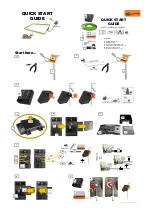
34
4 Construction and Function
Mounting and Operating Instructions CEAG Central Battery System ZB-S 40071860179 (L) November 2018 www.ceag.de
4.4.3 Baterie Control Modul BCM
Indicators
O
O
ON LED
The LED lights up when the
BCM is in operation. If the
LED does not light up then the
BCM is faulty or there is no
mains supply or a function test
has been triggered.
O
O
Boost Charge LED
The Boost Charge LED lights
up during boost charging, e.
g. following a mains failure or
operating duration test.
O
O
Charge Fault LED
The light emitting diode
charge fault lights up when
the BCM, the charge booster CM 1.7 A and CM 3.4 A
or the batteries are faulty. Further error messages can
be queried via the control unit. With faults of the CM 1.7
and 3.4 A modules, error display relates to the module
address.
O
O
ISO-Failure LED
The Light emitting diode ISO-Failure lights up when an
isolation fault exists in the battery circuit.
Connection terminals
The terminals are of the push-lock type.
The terminals can be unplugged to assist installation.
O
O
Potential-free signal contacts
Potential-free signals can be relayed with terminals
„11-12“, „21-22“, „31-32“ (connection max. 0,5 A/24 V AC/
DC).
The contact 11/12 is closed in the event of fault.
The contact 21/22 is closed in the event of an insulation
failure.
The contact 31/32 is closed during boost charging.
O
O
Temperature sensor
An external temperature sensor must be connected to
terminals F+ and F-. The temperature sensor must be
connected using a screened 2-core cable. A conductor
size of 0.5 mm² is adequate for cable runs < 50 m as the
measuring current is very low.
O
O
measurement of battery current
Battery current is measured via a measuring shunt via
terminals I+, I-.
O
O
CCB bus connection terminals for charging boosters
CM 1.7 A and CM 3.4 A
The Charge Control Bus (terminals CCB +, CCB -) controls
and monitors the charging boosters CM 1.7 A and CM 3.4 A.
O
O
Ter - BST
2.5 A boosters are controlled via the terminals.
O
O
Ter - 24V
The BCM module is supplied via the DC/DC converter .2
via the terminals.
ATTENTION!
The CCB bus is not designed as a SELV system. The bus
components must be handled as if mains supply (240V) is
applied.
4.4.4 Charging module CM 1.7 A
and CM 3.4 A
A suitable number of charge modules should be planned
for complying with the legislative recharging duration for
the planned battery sets.
The CM modules have their own calibrated charge
control and also function independently of the BCM. With
integrated fan monitoring.
















































